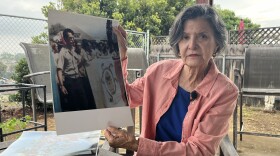A binational group of academics, business leaders and government officials met in Chula Vista last week to discuss one of the region’s most pressing issues — long border wait times.
Hours-long waits to cross both into the U.S. and Mexico cost the region billions of dollars and thousands of jobs, according to a 2021 report from SANDAG.
“As a result of extended wait times from people crossing the U.S.-Mexico border between San Diego and Tijuana, we lost over 80,000 jobs and we also lost $3.4 billion in economic activity,” the report states.
Lost money and jobs formed the basis for the South County Economic Development Council’s (EDC) Binational Forum Wednesday.
San Diego County Supervisor Nora Vargas, who attended, said stubborn issues like long-border waits are holding the region back.
“The economic potential of this region, I think, is really something that we haven’t really maximized yet,” she said.
South County EDC President Jim O’Callaghan said bringing experts from both sides of the border together in-person was long overdue.
“While we have great online conversations and we get amazing phone calls, there’s nothing like having everybody in one room at the same time,” he said.
At the inaugural forum, Kurt Honold, secretary of economy and innovation for Baja California, laid out a vision for alternative border crossings.
It included new ways of crossing the border that would ease traffic flows at both the San Ysidro and Otay Mesa ports of entry.
They involve public-private partnerships, similar to the one used to build the CBX or Cross Border Xpress, a hugely popular crossing exclusive for people traveling to and from the Tijuana Airport.
Honold is proposing an actual CBX but for people who ride the trolley.
“The trolley CBX would have a bridge on the Mexican side that will land at CBP installations in San Ysidro,” he said. “Then they can go to the trolley right away.”
He contends this might reduce the number of total vehicles waiting in line to cross the border.
Another idea that Honold is actively pursuing is a ferry that would transport people from Ensenada directly to downtown San Diego. The ride would take a little more than two hours, which is still faster than driving across, he said.
Like the CBX trolley idea, this would reduce the number of cars on the road.
Honold said he is working with a partner in San Diego and could be doing test runs as early as this summer.
Jim Dolan, a regional investment director at U.S. Bank, also attended the Binational Forum.
He said the pandemic showed us just how crippling supply chain disruptions can be.
“The disruptions in the supply chain due to COVID, the backlog of goods that are just not reaching the demand, are causing all this inflation,” he said.
The San Diego-Tijuana border is an important part of the global supply chain.
Tijuana is a manufacturing hub where companies from all over the world set up operations for American consumers. When the Port of Long Beach was overwhelmed during the pandemic, people began sending cargo down to the Port of Ensenada and driving it over the border.
-
The economy may not be the first thing that comes to mind when San Diegans think of the border region. But the region known as Cali-Baja is an economic powerhouse.







